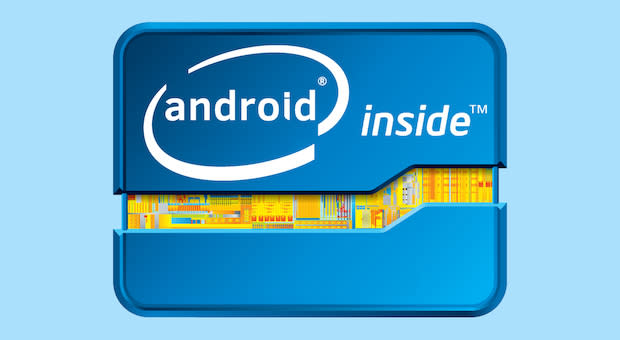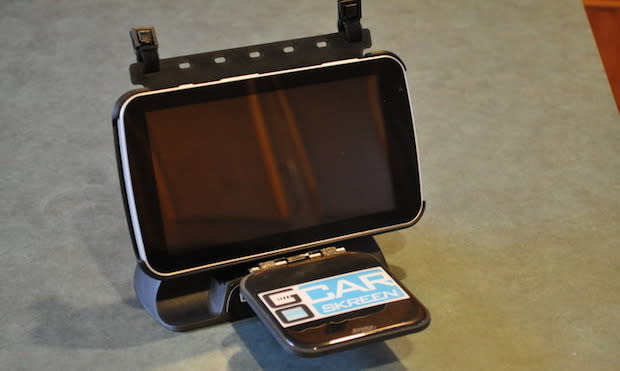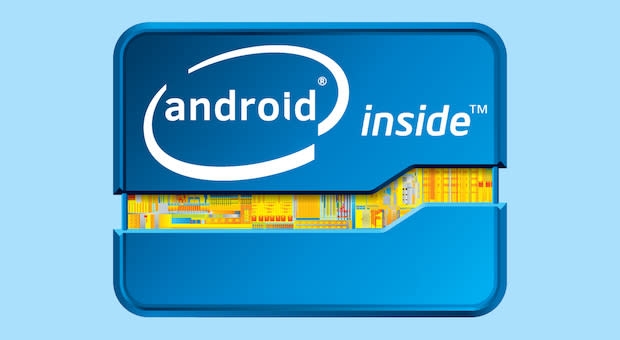Switched On: Android (tablet) inside

Each week Ross Rubin contributes Switched On, a column about consumer technology.
Inexpensive 7-inch tablets were everywhere in 2013 and became, as Switched On noted in December, a populist platform that fulfilled the promise of the sub-$100 PC. But despite their exceptional portability, aided by light weight and slim profiles, some may find the mere act of dragging them within range of something like their boombox, television or car to be too daunting a chore. Worry not, lazy but intrepid crowdfunders. Kickstarter has recently debuted a trio of products that integrate an Android tablet experience for your enhanced enjoyment, productivity and mobility.
The Boombox

The Auris Wily is a shiny, oblong portable audio device similar to many we've seen from Logitech, Jambox and others. It claims some appealing audio specs in a lightweight device. But of course what sets it apart from those products is the front-and-center mounting of a 7-inch Android tablet. Is it a tablet with superior speakers or a boombox with better intelligence and usability?
Regardless, while Switched On has previously questioned the utility of making the whole Android app library available on platforms such as TVs and cameras, there seems to be a stronger case for it on the Wily. Obviously, a wide range of audio applications such as Pandora, Spotify and Audible make sense. The Wily also has an HDMI connector for filling in the gap on that smart TV that may not have all the services you'd like. And it can even serve as a standalone device for internet calls or video chats.
The Wily was close to its $65,000 funding goal, but Auris pulled the project owing to an apparent breach of confidentiality on the part of its contract manufacturer. The next Switched On will delve into how Auris and Kickstarter dealt with the cancellation. Fear not, though. While the Wily will probably return to solicit funds at some point, those who want their Android tablet-enabled portable audio a bit more rectangular can look forward to a series of "smart audio" products announced by Vizio at CES.
The Landline

The HFC Canna is one of the most retro-tech ideas seen in a long time. Companies such as Panasonic and Hisense have shown cordless-phone systems with handsets that are essentially low-end Android devices. But the Canna goes for a bigger screen and drops any pretense of a wireless handset by putting a 7- or even 10-inch Android tablet smack-dab in the middle of a landline phone.
Apps such as Skype and WhatsApp make some sense in this context. But the more interesting work is around the core voice calls for which we use a landline. A Contacts app makes dialing from a landline less of a memorization chore. Answering machine messages can be saved as easily transferred MP3 files, and calls can be recorded with the touch of a button (and permission, if one is prudent). Pledge levels to obtain the Canna's various flavors range from a $199 early bird to $399 for a version that can connect to a cordless (DECT) system. For those chained to their desks and who live off their landline, it may be worth a look. But otherwise, it will be tough to find those who find their landline that valuable.
The Ride

If jamming an Android tablet into your home phone and portable boombox aren't enough, how about taking it on the road? Despite looking remarkably like a 7-inch tablet, the creatively spelled CarSkreen is merely a display suspended somewhere conspicuous in your center console with a harness. A wee shelf is provided to hold your smartphone, which must handle all input tasks.
By showing navigation and music apps (and hopefully nothing too distracting beyond that) on the slightly bigger display, one combines the enlarged real estate of displays built into car consoles or premium aftermarket car stereos with the flexibility and responsiveness of modern apps. Pledges to obtain the device start at over $300, which would cover a 7-inch tablet and quite a bit of tethering.
Indeed, while the campaign page lists a number of other potential alternatives to the CarSkreen in a favorable (surprise) comparison chart, the most obvious alternative -- a cellular-enabled tablet -- is unlisted. In addition, emerging standards such as MirrorLink and iOS in the Car promise to make this kind of functionality more widespread in the coming years. Still, if you're committed to one unshared data plan and don't mind the front interior of your car looking a bit like a miniature suspended scaffold, you can join the cause for it materializing in May.
Ross Rubin is principal analyst at Reticle Research, a technology, media and telecom advisory firm, and founder of Backerjack, which covers crowdfunded product innovation. He blogs at Techspressive.

